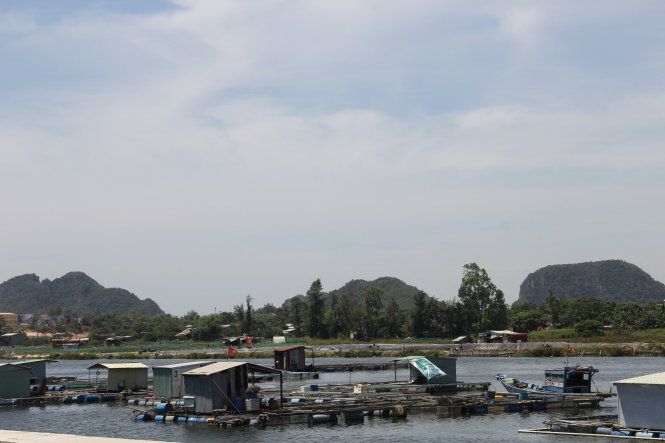The administrations of Da Nang City and neighboring Quang Nam Province have been making efforts to rejuvenate a ‘dead’ river which will serve as a ‘bridge’ to promote the two cities’ ecotourism.
Over the past few years, authorities in Da Nang City and Quang Nam Province, home to the UNESCO-recognized Hoi An Ancient Town, have both agreed to give priority to the ‘revival’ of the Co Co River.
The watercourse, which meanders from Da Nang and past Ngu Hanh Son Mountain to Hoi An Ancient Town, plays a pivotal role in the area’s efforts to develop usable urban space along the riverbanks, and provide a boost to ecological connectivity and ecotourism.
According to Tran Dinh Quang, deputy head of the management of Chu Lai Open Economic Zone in Quang Nam, the government has recently approved a project to dredge the Co Co River, and earmarked VDN425 billion (US$18.5 million) to make it happen.
Another VND425 million will be taken from the provincial coffers.
The project, expected to be completed by the end of 2019, will be implemented along the section of river that spans 14 kilometers from Hoi An City to Dien Ban Town, and involve the construction of seven bridges, Quang added.
The Da Nang administration has almost finished clearing its stretch of river.
Locals from both areas have long wanted to see the river return to its heyday as the arterial watercourse it was decades ago.
Ngo Bay, a Ngu Hanh Son resident and veteran angler in his 70s, was considered an otter during his five decades of fishing on the T-junction of the Han and Co Co Rivers.
His son now runs a fish farm in the same waters.
Now that he has ‘retired,’ Bay sometimes sits on the riverbanks, and often reminisces about his youth.
According to the head monk of a pagoda he visited as a child, the Co Co River, which connected Hoi An and Da Nang, or Faifo and Tourane as they were called by the French, bustled with trading activity as local merchants had no roads to travel on back then.
The waters were even infested with crocodiles, the boy was told.
Bay, however, never had the opportunity to confirm such word of mouth, as several sections of the river had already been filled up or narrowed, preventing boats from cruising from Da Nang straight to Hoi An, before he reached adulthood.
Following its heyday, the Co Co River suffered from serious narrowing during the eventful 19th century, leaving vessels unable to dock at its ports, Bay recalled.
The watercourse has since been void of life and fallen into disrepair.
An investigation by Tuoi Tre (Youth) newspaper found at least two historical references that lend weight to Bay’s accounts of the Co Co River being the arterial waterway that it was back in the 17th century.
 |
| The end section of the Co Co River, which flows through Hoi An City in the central province of Quang Nam, has been teeming with tourist activity in recent years. Photo: Tuoi Tre |
One of them, Hai Ngoai Ky Su (Overseas Chronicles), was written by venerated Chinese Bonze Thich Dai San (1633-1705), better known as Thach Dau Da, during his 1685 stay in ‘Dang Trong’ (Inner Half, aka Cochinchina), at the invitation of Lord Nguyen Phuc Chu.
Dang Trong was the area stretching southward from the Gianh River in the north-central province of Quang Binh.
The area was ruled by the Nguyen lords, one of the two ruling families of Vietnam, during the 17th century Trinh-Nguyen civil war.
He recalls in Episode 4 that after dozing off for about half an hour on a boat which departed from Hoi An and drifted along the Co Co River, he woke up, to his delighted surprise, to the charming scenes of Da Nang, adorned with lush vegetation and a multitude of white doucs, which are indigenous to the local forests.
The monk also dropped by Tam Thai Mountain, a part of Da Nang’s iconic Ngu Hanh Son mountain cluster, and composed several poems in praise of the peak.
Dai Nam Nhat Thong Chi (Geographical, Historical Record of the Great Country of An Nam) confirms the information.
It can be concluded therefore that Co Co was previously a beautiful river which also held strategic significance in terms of transport, trade and tourism and served as the main arterial route connecting the then Hoi An and Da Nang.
As observed by Tuoi Tre reporters, unlike in Quang Nam, where Co Co becomes so narrow in some places that even small boats cannot navigate it, the watercourse has more river-esque characteristics in Da Nang.
Lining it are a long-established residential area on one side and the under-construction Hoa Xuan eco-friendly housing complex on the other.
Fishermen residing along the riverbanks have long switched to raising caged fish.
The area also boasts a nationally recognized K20 historical relic, a revolutionary base built during the American war in Vietnam, with several short tunnels and bunkers kept intact.
Another must-see for tourists is a large pagoda currently being restored on Hoa Son Mound, part of the Ngu Hanh Son mountain cluster.
More than 10 eco-friendly residential areas and luxury golf courses, including Montgomerie Links, can be seen along the eight-kilometer stretch of Co Co in Da Nang.
Le Ha, an elderly from Dien Ban District, confirmed that Co Co was indeed a large river around 50 years ago.
“I used to swim there. However, the river shrank in size because of the natural accumulation of alluvium, locals building dykes to reduce salinity, and makeshift roads,” Ha explained.
The old lady also expressed her desire to witness the beloved river’s facelift before her time runs out.
Like us on Facebook or follow us on Twitter to get the latest news about Vietnam!



















































